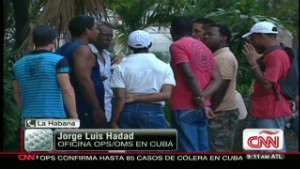The patients that arrived
for treatment in mid-June at hospitals in Manzanillo had all gone to
the same birthday party held at a house in the hilly countryside on the
perimeter of the eastern Cuban city.
The sick had eaten shrimp
at the party and doctors thought that meal might be the cause for the
patients' heavy vomiting and diarrhea.
Then more people began walking into hospitals with similar symptoms.
But they had not attended the party.
 Casos de cólera en Cuba
Casos de cólera en Cuba
"They started coming in a
few at a time," said Julio Cesar Fonseca Rivero, the director of the
Celia Sanchez Manduley Hospital, the largest in the region. "The first
day five came, and then eight. That's not normal, that five people would
come with the same symptoms. The most critical days were when there
were 30 to 32 patients who arrived in a single day."
A sudden spike in cases
of diarrhea is not unusual for Manzanillo's hospitals that treat the
surrounding rural communities. There residents often live without indoor
plumbing and in the summer months endure the scorching heat and heavy
rains.
This summer had already been particularly hot with heavy rains that caused outhouses to flood into several drinking wells.
Still, doctors suspected they were dealing with something they hadn't seen before.
"We became alarmed with
the number of cases arriving. We usually see one or two cases of
diarrhea each day," said Dr. Oyantis Matos Zamora, who oversees a clinic
on the edge of the city that attends to rural residents.
The symptoms some
patients exhibited -- the rapid onset of watery diarrhea and dehydration
— had also not been seen in generations.
"The way that the
outbreak developed and the appearance of other similar cases in the
region, we realized this was a problem of a different magnitude," said
Dr. Manuel Santin Peña, Cuba's national director of epidemiology.
The "problem" was cholera.
Cuba's last cholera
outbreak occurred over a century ago. Although eradicated in many
countries, the disease, according to the World Health Organization,
still infects between 3 million and 5 million people each year, killing
between 100,000 and 120,000.
In Manzanillo the outbreak has taken on a name of its own. There it's simply referred to by residents as "el evento."
So far "el evento" has
taken three lives and infected at least 110 people, said Santin. He said
doctors were waiting on test results for tens of other possible cases
but said so far fewer than 30% percent of suspected cases had been shown
to be cholera.
He denied reports that
the Cuban government has underreported the death toll or that the
outbreak is spreading to other provinces.
He said a handful of
suspected cases had been identified elsewhere in the country. But he
said those cases had come from the same region where the original
outbreak took place and are believed to have been infected there.
"We can categorically
say that there is no other outbreak in any other province," Santin told
CNN, outside the entrance to the Celia Sanchez Manduley Hospital, where
three more people had arrived suffering from severe diarrhea.
Cuban health officials
allowed a CNN crew to be the first media to film in the hospital and
speak with doctors there about the ongoing effort to control the cholera
outbreak.
To combat the outbreak,
the local government has closed 12 contaminated wells around Manzanillo,
Santin said. Clean water is being trucked in for residents until a
different source of water can be found.
At the entrances to
hospitals and government buildings in the city stand buckets for people
to wash their hands and soles of their shoes with chlorine bleach.
No comments:
Post a Comment